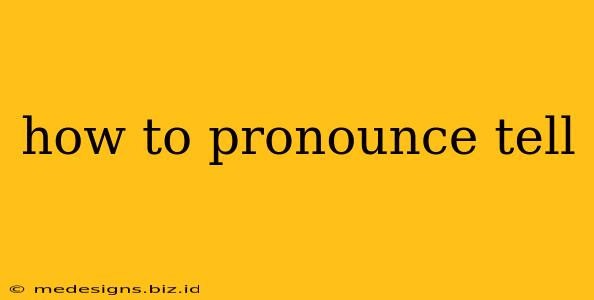The word "tell" is a common English verb, but its pronunciation might trip up some learners. This guide will break down how to pronounce "tell" correctly, covering different aspects to ensure clarity.
Phonetic Transcription and Sounds
The phonetic transcription of "tell" is /tɛl/. Let's break down each sound:
-
t: This is a voiceless alveolar plosive. Place the tip of your tongue against the ridge behind your upper teeth, then release the air with a slight puff. Think of the "t" in "top."
-
ɛ: This is a lax, mid-front, unrounded vowel. Your tongue should be relatively flat in your mouth, and your lips should be relaxed. Think of the "e" in "bed." It's not the long "e" sound as in "see."
-
l: This is an alveolar lateral approximant. Place the tip of your tongue against the ridge behind your upper teeth, but allow air to escape over the sides of your tongue. Think of the "l" in "light."
Common Mistakes and How to Avoid Them
Many learners struggle with the vowel sound in "tell." Here are some common mistakes and how to avoid them:
-
Pronouncing the vowel too long: Don't drag out the vowel sound. The "ɛ" sound is short and quick.
-
Using the wrong vowel: Avoid using the long "e" sound as in "see" or the short "i" sound as in "pin." Focus on the "e" sound in "bed."
-
Adding an extra sound: Some learners might add an extra schwa sound (/ə/) at the end, making it sound like "telluh." Focus on a clear and crisp pronunciation of /tɛl/.
Tips for Practicing Pronunciation
The best way to learn to pronounce "tell" correctly is through practice. Here are some tips:
-
Listen to native speakers: Listen to audio recordings or videos of native English speakers saying the word "tell" in different contexts. Pay attention to the vowel sound.
-
Repeat after native speakers: Imitate the sounds you hear. Try to match the pronunciation as closely as possible.
-
Record yourself: Record yourself saying the word and listen back. This can help you identify any areas where you need improvement.
-
Use the word in sentences: Practice using the word "tell" in sentences to improve your fluency and natural pronunciation. For example: "Can you tell me the time?", "I'm going to tell you a story.", "She likes to tell jokes."
Mastering the Subtleties of Pronunciation
Even small differences in pronunciation can affect understanding. By paying attention to the individual sounds and practicing regularly, you'll master the correct pronunciation of "tell" and improve your overall spoken English. Consistent practice is key to achieving accurate and confident pronunciation. Remember to focus on the short "e" sound and avoid adding extra sounds. Good luck!
